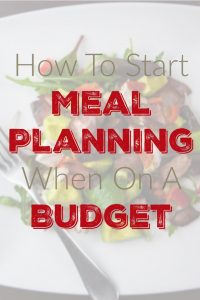Ever since the year started, I’ve made it a point to begin meal planning. It didn’t only help me with my weight loss goals, but it also controlled my sugar intake! Plus, it’s helped me stay under budget, which was a huge relief since I also have financial goals in mind. But it can get quite tricky trying to find an effective low-carb meal plan to follow for the week. That’s why I would love to help you out and give you some tips on meal planning on a budget!
How To Start Meal Planning When On A Budget
When you think about it, planning low-carb meals is simple. I only remember four steps when doing so:
-
Plan
Planning is the first thing to do so you can stay on track with what you eat and how much you spend. That’s why I recommend that you keep a journal or notebook where you can list down meals you are interested in cooking for the whole week. The notebook should be filled with your meal plan and grocery list, so you know what to purchase in the supermarket. No more spontaneous purchases and extra snacks that add up to your calories and expenses!
Begin by searching up for easy low-carb meals online. I recommend that you bulk up on healthy fats and lean protein, such as olive oil, chicken, and don’t forget your dark leafy greens!
Check out what you still have in your kitchen or pantry to avoid multiple purchases as well. Go for cooking meals in bulk and what you feel comfortable with eating for the entire week.
2. Shop
What makes people hesitant on making low-carb meal plans is that some of the ingredients are very expensive! But you’ll be surprised that a ton of food is pretty cheap, as long as you know how to shop right. It’s best to go for cheaper alternatives when shopping, purchasing regular cheeses (not specialty!) and real meats like drumsticks or roast beef. Go for cheaper cuts of meat. They are a bit tough but using a slow cooker or casserole will make it very soft and delicious.
Kale is popular but expensive. It’s best to put that back and go for cheaper dark leafy greens with the same amount of nutrients! Also, if you want to save, it’s best not to purchase a lot of nuts or fruits that aren’t in season (like avocados). As for fish, I recommend frozen or canned fish, which is cheaper and handy when feeling hungry.
I recommend that you buy and eat in season, purchasing quality food that still sticks to your budget. Sure, organic vegetables are nutritious, but they’re also expensive. You can even get enough nutrition with regular eggs and veggies!
Also, purchasing in bulk is less expensive than individually packaged foods. You can also buy vegetables from your local farmer’s market, which is cheaper than the supermarket!
When shopping for drinks, avoid having sugary juices or sodas. Black coffee or tea for your caffeine fix is excellent but prevent the sweet add-ons like full cream milk!
3. Cook
When meal-planning, you have to learn how to cook! I follow the saying, “cook once, eat twice.” Cooking in bulk and leaving leftovers will be amazing in saving time and money compared to preparing different meals with various ingredients.
I recommend that you learn how to slow cook meats, and to stir-fry vegetables with a lot of flavors using seasonings and spices. I like cooking my meals with butter or other healthy fats to increase the amount of fat. It’s best to go for simple meals that are high in fat, moderate in protein, and with non-starchy vegetables. As for dessert, I opt to skip it to avoid the added sugars!
4. Eat
Last but not the least, it’s time to eat! Stick to your meal plan and avoid going overboard on the amount of food you put on your plate. Avoid food wastage or snacking. Freeze leftovers when needed and pack your food for lunch when at work!
Also, avoid temptation. Don’t eat when you’re bored and know the difference between hunger and craving. If you do feel like you’re about to have a sugary snack, either drink a glass of water or distract yourself, taking a walk helps!
Wrapping It Up
And there you have it! Through being organized and ensuring that you stick to your plan, you’ll reach goals and stay healthy this 2018. All it takes is to learn a few cooking skills and stay motivated.
Hopefully, I was able to inform you more about how meal planning works and what you can do to begin. So let’s start surpassing our goals with a low-carb meal plan without overspending today!
For those who would like to ask questions or share their experiences and advice on meal planning, then comment below. All your contributions are much appreciated.
Don’t miss a post! Click here to sign up for our daily email!


2 thoughts on “How To Start Meal Planning When On A Budget”
-
Pingback: The My Sugar Free Journey Podcast – Episode 74: Dr Chris Masterjohn | My Sugar Free Journey
-
Pingback: 3 Tricks To Score Cheaper Meat For Your Ketogenic Diet
Leave a Reply